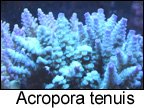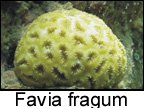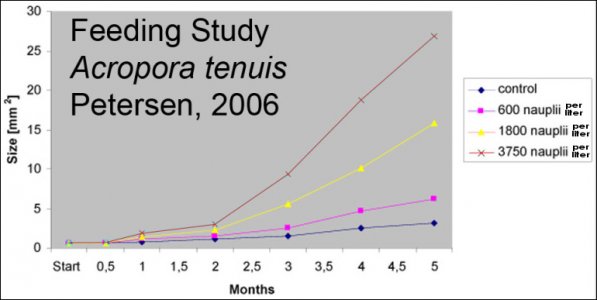Ok more fish poop!...
"Here is a nice frag-feeding study that you can repeat at home if you want to. It was originally done in an aquarium, with very tiny frags, to help people who grow corals as a business:"
"Influence of different food sources on the initial development of sexual recruits of reefbuilding corals in aquaculture. Publication: Aquaculture, 2008"
"In order to test food supply as a controlling factor in coral aquaculture using sexual reproduction, we compared the influence of three different food sources (Artemia nauplii, phytoplankton, and a commercially available algal suspension) on the growth and survival of early recruits of two scleractinian reef corals for 5 months."
"The brooding coral Favia fragum, and the broadcast spawner Acropora tenuis, were used as model species in the present study."
"Three food sources that are commonly used in aquaculture were tested: (1) Freshly hatched nauplii of the brine shrimp (Artemia salina; size: 600 µm; Select Brine Shrimp Eggs; Salt Creek, Inc., USA) are the most commonly applied live food organisms in aquaculture. (2) Phaeodactylum tricornutum is a pelagic diatom which is routinely cultured at the Rotterdam Zoo. (3) Nori Micro (Zoolife, U.K.) is a commercially available dry food for aquatic invertebrates which can be applied directly when suspended in water. [...] The food was added once everyday for a duration of 5 months. Besides considering their relevance in aquaculture, the different food sources were chosen in regard to their application at Rotterdam Zoo. The three food types had been routinely added to the multi-species coral exhibits on a daily basis to supply non-selectively fish, corals, and filter feeders with nutrients. The present study used these given food types to evaluate their importance for early [reproduction] recruits of both coral species."
"Primary polyps [of Acropora tenuis, and Favia fragum], kept in 2-liter aquaria, were daily fed with freshly hatched Artemia salina [brine shrimp], micro algae Phaeodactylum tricornutum, and a commercially available dry food (Nori Micro, Zoolife), respectively, at various concentrations. Growth rates in both species were significantly higher in the Artemia (pods) treatment, with maximum rates of 9.4 square mm/month for Favia fragum, and 26.8 square mm/month for Acropora tenuis, compared to all other treatments and the control (no additional food)."
"Highest growth rates of 9.4 square mm/month were attained under the highest Artemia concentration, whereas growth in the control was 1.8 square mm/month. Corals grew faster under the highest Artemia concentration during the entire period of the experiment, compared to the control."
"Growth differed highly between the treatments during the entire experiment. Highest rates were attained with 26.8 square mm/month under the highest Artemia concentration, compared to a mean colony size of 3.2 square mm/month in the control. Corals under the highest Artemia concentration grew faster than the control from the beginning of the experiment; growth under the highest Artemia concentration increased relatively faster compared to all other regimes until the end of the experiment."
"Regarding the Nori feeding regimes, [...] Nori did not have any concentration-dependent effect on coral growth."
"The present study clearly shows that Artemia nauplii (pods) increased the growth of sexual recruits in the chosen scleractinian coral species. Growth rates increased with food concentration, leading to colonies sizes that were more than eight times higher in Acropora tenuis, and more than five times higher in Favia fragum, compared to the controls. [...] We worked with relatively low light levels in the present study."
"The present study shows that similar growth rates can be obtained on horizontal and vertical surfaces if additional food sources are supplied. Therefore, in a less favorable environment with higher algal growth and sedimentation, overall coral recruitment success (growth and survival) might be enhanced in vertically settled corals providing that additional food is supplied."
"The alternative food sources, the unicellular algae Phaeodactylum tricornutum, and the commercial algal powder (Nori Micro), showed overall no influence on the growth of the tested corals compared to the control. Our results confirm previous observations that adult scleractinians [corals with stinging polyps] are usually not herbivorous. As a consequence, the application of such food sources in multi-species coral exhibits in public aquaria was to be well considered. In future studies, alternative zooplankton food sources such as rotifers or copepods should be compared with Artemia nauplii."
"Besides other factors, such as light and water movement, planktonic food plays an important role in the development of adult corals."
Video of zooplankton; you can see their faces (turn off HD if it skips):
http://www.vimeo.com/5380457
Many more closeups:
http://www.youtube.com/watch?v=aIFiWrGwAZY
Catching plankton with nets:
http://www.youtube.com/watch?v=5dRrn2gDrAA




